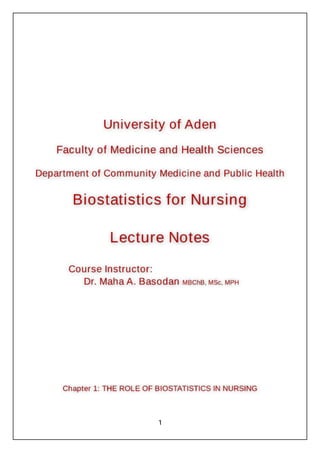Biostatistics FOR NURSING 1.docx.pdf
•
0 likes•1,899 views
This document discusses descriptive and inferential statistics, and how to organize data into frequency distribution tables. Descriptive statistics summarize data, while inferential statistics are used to generalize results to populations. Frequency distribution tables arrange data into class intervals to show the distribution of a variable or combination of variables. The tables include the class, frequency, relative frequency, and cumulative frequency. An example frequency distribution table is provided using data on number of children from 20 individuals.
Report
Share
Report
Share
Download to read offline

Recommended
Recommended
More Related Content
What's hot
What's hot (20)
Note on Evaluation and Assessment in Nursing Education (Part - 01)

Note on Evaluation and Assessment in Nursing Education (Part - 01)
Babitha's Note on Unit 01: Introduction to Research & Research Process

Babitha's Note on Unit 01: Introduction to Research & Research Process
Similar to Biostatistics FOR NURSING 1.docx.pdf
Similar to Biostatistics FOR NURSING 1.docx.pdf (20)
2.1 frequency distributions for organizing and summarizing data

2.1 frequency distributions for organizing and summarizing data
Tabulation of Data, Frequency Distribution, Contingency table

Tabulation of Data, Frequency Distribution, Contingency table
STATISTICAL PROCEDURES (Discriptive Statistics).pptx

STATISTICAL PROCEDURES (Discriptive Statistics).pptx
Recently uploaded
Recently uploaded (20)
IGNOU MSCCFT and PGDCFT Exam Question Pattern: MCFT003 Counselling and Family...

IGNOU MSCCFT and PGDCFT Exam Question Pattern: MCFT003 Counselling and Family...
Z Score,T Score, Percential Rank and Box Plot Graph

Z Score,T Score, Percential Rank and Box Plot Graph
Measures of Dispersion and Variability: Range, QD, AD and SD

Measures of Dispersion and Variability: Range, QD, AD and SD
Measures of Central Tendency: Mean, Median and Mode

Measures of Central Tendency: Mean, Median and Mode
social pharmacy d-pharm 1st year by Pragati K. Mahajan

social pharmacy d-pharm 1st year by Pragati K. Mahajan
Call Girls in Dwarka Mor Delhi Contact Us 9654467111

Call Girls in Dwarka Mor Delhi Contact Us 9654467111
Russian Escort Service in Delhi 11k Hotel Foreigner Russian Call Girls in Delhi

Russian Escort Service in Delhi 11k Hotel Foreigner Russian Call Girls in Delhi
Biostatistics FOR NURSING 1.docx.pdf
- 1. 1
- 3. 3
- 4. 4 DESCRIPTIVE (DEDUCTIVE) STATISTICS: INFERENTIAL (INDUCTIVE) STATISTICS:
- 5. 5 - -
- 6. 6
- 7. 7
- 8. 8
- 9. 9
- 10. 10
- 11. 11 - :
- 12. 12 - , , : - - -
- 13. 13 In Medicine and related paramedical practices we will be dealing with qualitative variables, that could be nominal or ordinal, and with quantitative variables, that could be continuous or discrete. The classification of the data, according to the scale of measurement used, is very important. The classification of data is usually made by frequency distribution tables of one variable or a combination of variables. The scale of measurement is the way in which each element may be represented by a given measure unit. Any scale of measurement must have two main conditions: - To be exhaustive: Include all elements - To have classes or categories mutually exclusive Each element ought to be considered only once For data to be more easily appreciated, it is often useful to arrange the data in the form of a table. Quite often, the presentation of data in a meaningful way is done by preparing a frequency distribution table.
- 14. 14 - : is the characteristic by which the data of a variable are grouped. - : could be defined as the way in which the characteristics of the quantitative data are used with grouping purposes. - : is the difference between the lower and upper class boundaries and is called "class width", class length" or " class size". Class width= Maximum value of data - minimum value of data number of class intervals wanted - is midpoint of a class interval - : frequency or class frequency is the number of observations falling into each class or class interval. - : is the absolute frequency of class divided by the total frequency of all classes. The relative freq. of a class= absolute frequency of the class divided by Total frequency of all classes. - is the sum of the frequencies up to a given class or class interval. - When the class interval has lower and upper class limits. - when at least theoretically either no upper class limit or no lower class limit indicated. The table below shows the data collected from 20 individuals. 7 M 3 176.4 6 M 4 180 5 F 3 167.2 4 M 0 168.3 3 F 0 149 2 M 1 164.2 1 M 2 151.3 Number of element Sex Number of children Height (Cms.)
- 15. 15 20 F 5 168 19 M 6 172.4 18 M 4 167.3 17 F 3 159.3 16 M 2 155 15 M 1 157 14 F 0 152 13 F 1 148.2 12 F 2 145 11 M 3 160 10 M 4 157.2 9 F 5 145.1 8 M 6 151 We want to do a frequency distribution tables for the data of the 3 variables listed in the table.
- 16. 16 - C Frequency distribution of the No. of children
- 17. 17
- 18. 18
- 19. 19